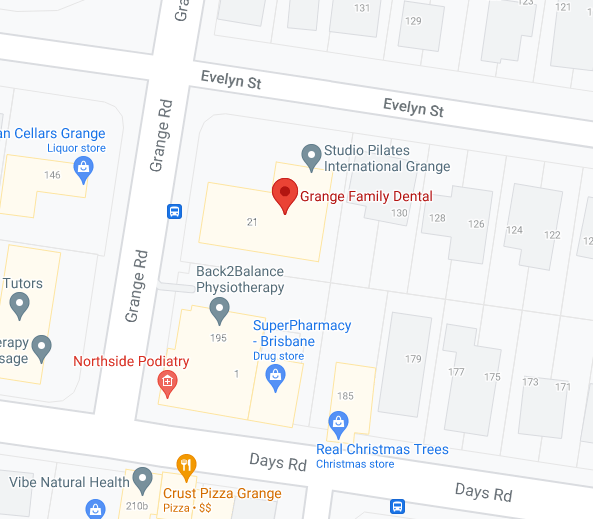Cosmetic Dentist Brisbane
At Grange Family Dental, we offer premium quality cosmetic dentistry, to give you a smile that you can be proud of. As a trusted family dentist in Brisbane, you’ll absolutely love our incredible staff. Our caring cosmetic dentists are with you every step of the way, from your first assessment to the final result.
Grange Family Dental has over 20 years of experience offering cosmetic dentistry services of the highest calibre at prices you can afford. We have custom designed our own in-house lab, so we can have complete design and quality control of the entire process from check up to insert, and review the performance of our work for many years to come.
We’re so confident in our work that we include in-house guarantees on all procedures, from 6 months to 10 years, depending on your course of treatment.
Tooth Replacement Brisbane
Cosmetic dentistry is the range of dental treatments aimed specifically at enhancing the aesthetics, colour, and shape of your teeth.
While many general practitioners today perform fillings, caps and crowns, Dr Jeremy and his team at Grange Family Dental pride themselves on their prowess at cosmetic dentistry.
Cosmetic procedures use state-of-the-art materials and techniques to treat several common aesthetic dental issues including tooth wear, tooth erosion, crooked, cracked, discoloured, stained, chipped, missing, worn, and overlapping teeth.
Cosmetic Dentistry Brisbane
At Grange Family Dental we offer a take-home teeth whitening kit. At your first appointment, our qualified dentist or hygienist will take impressions of your teeth that are used to make your custom mouth trays. The special whitening gel is inserted in the trays and is worn for 60-90mins per day, for 7-10days.
We recommend that you have your teeth checked and cleaned prior to starting your teeth whitening treatment to ensure there are no cavities or gum disease present for best results. Great results occur for most patients, but it is important to consider any existing dental work you currently have, as fillings and crowns will not change colour.
What are Porcelain Crowns and Veneers?
Porcelain crowns and veneers in dentistry refer to “shells or sheets” of porcelain which are created to replace lost tooth structure. They are usually around 0.5-1.5mm thick and are very strong to withstand bite forces in patient’s mouth.
Veneers on the 2 front teeth

Porcelain crown and bridging treatment on upper teeth, and direct restoration of lower teeth using composite “white fillings”

What is involved in doing crowns/veneers?
In order to have sufficient strength to last many years, crowns/veneers require a minimum thickness of usually 0.5mm or more. This means on teeth where there isn’t enough room to fit the crown, a small amount of tooth structure needs to be milled down to allow room for the crown to fit. However, in many cases where crowns are needed, there is often already significant amounts of tooth structure missing so reduction is usually minimal.
Once the tooth is milled down to the ideal shape, a mould is taken and sent to the laboratory to fabricate the crowns. During this period of time, we will make a set of “temporary crowns or veneers” to ensure you are never without teeth.
Once the crowns/veneers arrive back from the laboratory, they are then “bonded” on to the teeth using a dental adhesive. A well made crown/veneer supported by a sufficient amount of tooth structure can usually expect to last up to 10-12 years although this can vary dramatically between people pending their bite strength and oral hygiene. At Grange Family Dental, we guarantee all crowns and veneers for the first 5 years so you can be sure you are always going to get good quality from us.
What are the benefits and limitations of crowns and veneers?
Porcelain crowns/veneers are extremely durable and when used properly in the right situation, should withstand the test of time. They can be used to completely change the colour and shape of your natural teeth and even strengthen or replace missing tooth structure in most circumstances.
However, crowns and veneers are only as strong as the amount of support provided by the underlying teeth, essentially “amplifying” the strength of existing tooth structure. Therefore in cases where there just isn’t enough tooth structure left, the longevity of crowns will be compromised as well.
An additional limitation of crowns/veneers is that they cannot change the position of your teeth. For a person with severely crowded or tilted teeth, crowns and veneers can only correct the colour and shape of the teeth but have a minimal impact on the alignment of the teeth. In these cases we often recommend you consider orthodontics in conjunction with cosmetic procedures to achieve your dream smile.
What are Dental Implants?
Most dental implants are made from various grades of titanium alloys and are shaped like a “hollow bolt”. Titanium and its alloys are biocompatible metals which fuse to the bone when allowed to heal without disturbance. The amount of time can vary from 10 to 12 weeks and at the end of the “healing period”, a porcelain crown can be fitted into the middle of the implant to replace any missing teeth.

How are implants put in?
Teeth implants are usually secured into the bone via minor surgery where the implant body is either “screwed in or tapped in”. After the healing period, the implant becomes completely fused to the bone and the “hollow” in the centre of the implant becomes housing for an abutment (connector). A crown is subsequently placed over the abutment to look and feel like a natural tooth. Sometimes where there isn’t enough bone, we can perform a “bone graft” to grow more bone into the desired area in order to hold the implant once placed. A bone graft can vary from using bone from other parts of the body to foreign or synthetic “bone chips” to encourage bone to grow into the desired area.
What are the Pros and Cons of implant dentistry?
Dental implants have long been considered the “gold standard” when it comes to replacing single missing teeth. Its strength and longevity make it the closest replacement to a lost natural tooth. When a good level of oral hygiene is maintained, dental implants have been seen to last more than 20 years and at Grange Family Dental, we guarantee all implants placed in house for the first 10 years*.
However, dental implants are not suitable for everyone, and must be considered on a case-by-case basis. As dental implants are held in by bone, in areas where there is insufficient bone, a dental implant may not be possible immediately until a bone graft is performed. Furthermore, if an implant is exposed to too much bacteria (plaque or tartar), it can become infected just like a natural tooth and possibly even drop out. Finally, certain medical conditions such as diabetes, osteoporosis or environmental factors such as smoking can also affect the success rate and lifespan of an implant. An experienced dentist should be able to advise you on the relative risks of all these factors.
This is a sample text. You can click on it to edit it inline or open the element options to access additional options for this element.

How is a bridge made?

A bridge is made by changing the shape of the 2 adjacent teeth to the gap. This allows us to fit a crown to each of these 2 missing teeth, and at the same time suspend a 3rd artificial tooth (or “pontic” tooth) onto these 2 teeth for support. A bridge is permanently fixed inside the jaw and does not move or come out and on average should last around 10 years or more when made well. It is possible to only use 1 adjacent tooth to create a bridge and such a design is known as a cantilever bridge and may be the preferred option in some situations. Bridges can also be fitted on dental implants as well in the same way its fitted on natural teeth.
What are the pros and cons of dental bridges?
In general, a dental bridge has a very high success rate and can be completed within 1-2 weeks in most cases. The result is immediate and compared to implants, there is no surgery and no healing period. The lifespan of a bridge is similar to that of a dental implant, and is certainly the preferred choice for patients for whom surgery is contraindicated (e.g. implants have lower success rates in smokers, or patients with uncontrolled diabetes).
Because bridges use 2 natural teeth to bear the load of 3 teeth, they may be contraindicated when the 2 adjacent teeth are already too damaged and weak and not appropriate for load bearing.
Equally, when the adjacent teeth are very healthy, a bridge may be contraindicated as cutting them down to place a bridge would unnecessarily weaken otherwise healthy teeth.
What is an Implant Supported Denture?

All forms of dentures have traditionally derived their support from either the remaining teeth or the gum. As we lose more teeth, this support dwindles and the denture becomes looser. Introducing implants under the denture to anchor the denture down can greatly increase the retention and stability hence the ability to chew with them.
How do implants improve the stability of the denture?
Often dentures sitting on nothing but gum will float around with little resistance resulting in difficulty in chewing/biting. When an implant is introduced underneath the denture, it can be joined to the denture via a “ball and socket” joint (or other designs) which allows the denture to grip onto the implant. As the implant is fixed to the jaw, the denture will no longer be able to move around when it’s tied down to the implant. Whilst multiple designs are available, just about all the designs will need the “connectors” to be replaced after a period of usage to maintain maximum tightness.
All On Fours Design

A common design for implant supported dentures is known as “all on four” and describes a design where a denture is fixed on 4 implants. In this design the denture is permanently fixed to the 4 implants and can only be removed by a general dentist with the right tools for regular maintenance. Please contact Grange Family Dental for more details of this procedure.
What are the pros and cons of implant retained dentures?
Implant retained dentures have revolutionised the use of dentures and given patients long troubled by poor fitting full dentures a much improved option. It dramatically improves the fit of the denture thus the quality of life of the patient. However, before an implant retained denture can be made, one must go through the implant surgery first and a 3 month healing period is usually required. Another limiting factor, is the availability of bone required to fit the implants may be reduced in patients who have been missing their teeth for a prolonged period of time.








